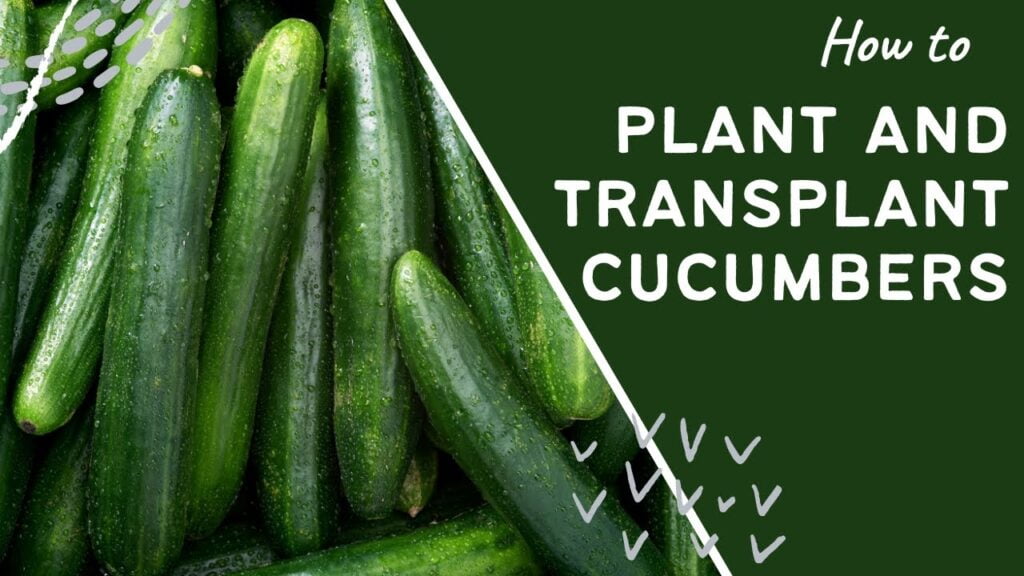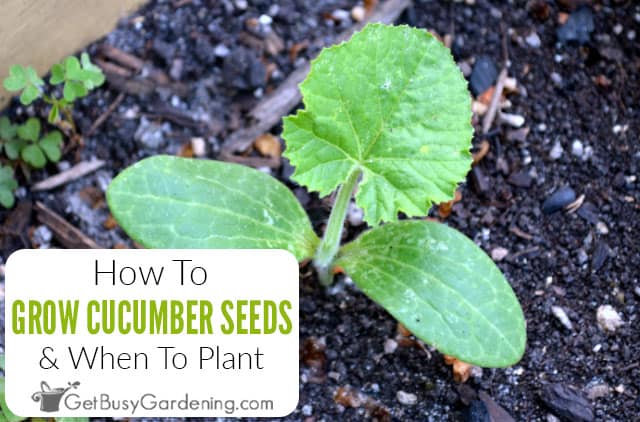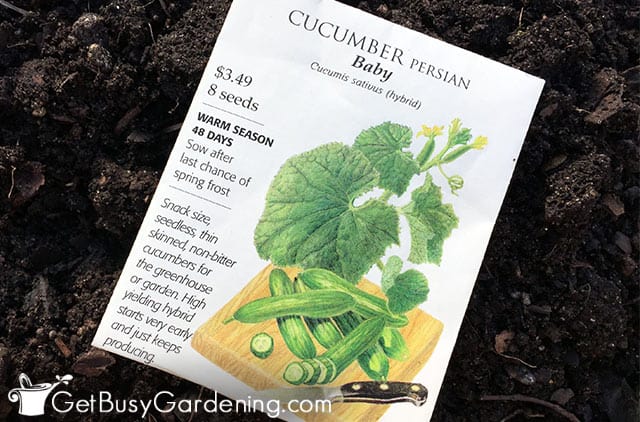So you’re ready to take your gardening skills to the next level and want to learn how to transplant cucumbers? Look no further, because in this step-by-step guide, you’ll discover everything you need to know to successfully transplant cucumber plants. Whether you’re a beginner or have some experience with gardening, we’ll walk you through the entire process, from preparing the soil to caring for your transplanted cucumbers. So grab your gardening gloves and let’s get started on this exciting journey of cucumber transplantation.

Preparing the Seedlings
Selecting healthy cucumber seedlings
When transplanting cucumbers, it’s crucial to start with healthy seedlings. Look for seedlings that have vibrant green leaves and sturdy stems. Avoid any seedlings that appear wilted, yellow, or damaged. Healthy seedlings are more likely to establish themselves successfully when transplanted.
Transplanting outdoors at the right time
Timing is key when transplanting cucumber seedlings outdoors. Wait until all threats of frost have passed and the soil has warmed up. Cucumbers are warm-season plants and thrive in temperatures between 60 to 90°F (15 to 32°C). Transplanting them too early can stunt their growth or even lead to their demise.
Hardening off the seedlings before transplanting
Before transplanting your cucumber seedlings, it’s crucial to harden them off. This process involves gradually exposing them to outdoor conditions, such as sunlight, wind, and lower temperatures, over a period of 7 to 10 days. Start by placing the seedlings in a sheltered outdoor location for a few hours each day and gradually increase the duration and exposure.
Choosing the Right Location
Selecting a sunny spot
Cucumbers are sun-loving plants that require at least 6 to 8 hours of direct sunlight daily. Therefore, choose a location in your garden that receives ample sunlight. Ideally, it should be a spot that is unobstructed by trees, buildings, or other structures that may cast a shadow.
Ensuring well-drained soil
Cucumbers prefer well-drained soil to prevent root rot and promote healthy growth. Avoid areas with heavy clay soil that tends to retain water. Instead, opt for loamy soil that drains well. If your soil doesn’t naturally drain well, consider amending it with organic matter or using raised beds to improve drainage.
Providing vertical support for vining cucumbers
To optimize space and encourage vertical growth, it’s beneficial to provide support for vining cucumber varieties. Install trellises, stakes, or a sturdy fence near your cucumber plants. This not only helps keep the plants upright but also promotes better air circulation, reduces disease risks, and makes harvesting easier.

Preparing the Soil
Removing weeds and grass
Before transplanting your cucumber seedlings, clear the area of any weeds or grass. These can compete with the cucumber plants for nutrients, water, and sunlight. Weeds can also harbor pests and diseases that can affect the health of your cucumbers.
Loosening the soil
Loosening the soil around your planting area is essential for healthy root development. Use a garden fork or a tiller to break up any compacted soil. This improves drainage and allows the roots to penetrate the soil more easily.
Adding compost or organic matter
Incorporating organic matter, such as compost or well-rotted manure, into the soil helps improve its texture and fertility. Spread a layer of compost over the planting area and mix it thoroughly into the top several inches of soil. This boosts nutrient levels and promotes healthy plant growth.
Adjusting soil pH if necessary
Cucumbers prefer slightly acidic soil with a pH range of 6.0 to 7.0. Test your soil’s pH using a soil testing kit, and if necessary, adjust it by adding lime to raise the pH or sulfur to lower it. Maintaining the appropriate pH level ensures optimal nutrient absorption by the cucumber plants.
Transplanting Procedure
Preparing the planting holes
Start by preparing the planting holes for your cucumber seedlings. Dig holes that are deep enough to accommodate the entire root ball of the seedlings. Space the holes according to the recommended spacing for your particular cucumber variety. Typically, cucumber plants should be spaced about 12 to 24 inches (30 to 60 cm) apart.
Gently removing seedlings from containers
Carefully remove the cucumber seedlings from their containers, taking care not to damage the delicate roots. If the seedlings are root-bound, gently tease the roots apart to promote healthy growth. Handle the seedlings by their leaves, as gripping or pulling the stems can cause damage.
Placing seedlings in the holes
Place each cucumber seedling in a planting hole, ensuring that the roots are fully covered and the seedling is at the same depth it was originally growing. Tamp the soil gently around the seedling to provide stability, but avoid compacting the soil too much, as it can hinder root growth.
Backfilling the holes with soil
Fill the planting holes with soil, ensuring that the seedlings are secure and upright. Gently firm the soil around the base of the seedlings to eliminate any air pockets. It’s essential to maintain good soil-to-root contact to facilitate nutrient uptake.
Watering the transplanted cucumbers
After transplanting the cucumber seedlings, water them thoroughly to settle the soil around the roots and eliminate any air gaps. Provide enough water to moisten the entire root zone, but be careful not to overwater, as it can lead to root rot. Ensure the soil remains evenly moist but not waterlogged throughout the growing season.

Protecting Transplanted Seedlings
Using row covers or cloches
To protect your transplanted cucumber seedlings from sudden temperature drops or pests, you can use row covers or cloches. These lightweight coverings create a mini greenhouse effect, retaining heat and providing a shield against pests while allowing sunlight and air to reach the plants.
Providing shade for delicate seedlings
In hot climates or during periods of intense sunlight, providing shade for your delicate cucumber seedlings can help prevent sunburn and heat stress. Use shade cloth, row covers, or even simple structures like umbrellas or shade sails to filter the sunlight and reduce its intensity.
Protecting from pests and diseases
Cucumbers are susceptible to various pests and diseases, including aphids, cucumber beetles, powdery mildew, and bacterial wilt. Implement preventive measures such as using organic pest control methods like companion planting, handpicking pests, and applying natural insecticidal soaps. Keep an eye out for any signs of pests or diseases and address them promptly to minimize damage.
Watering and Irrigation
Establishing a watering routine
Consistent and adequate watering is crucial for the health and productivity of cucumber plants. Establish a watering routine that ensures the soil remains evenly moist. Water deeply, providing enough moisture to penetrate the root zone. Monitor the weather conditions and adjust your watering frequency accordingly.
Avoiding overwatering or underwatering
Finding the right balance is key when it comes to watering cucumbers. Overwatering can lead to root rot and other moisture-related problems, while underwatering can stunt plant growth and reduce fruit production. Regularly check the moisture level of the soil by inserting your finger about an inch (2.5 cm) deep. If it feels dry, it’s time to water.
Using drip irrigation or soaker hoses
Consider using drip irrigation or soaker hoses to deliver water directly to the root zone of your cucumber plants. These methods minimize water waste by avoiding excessive runoff or evaporation. They also help keep the foliage dry, reducing the risk of diseases caused by prolonged leaf wetness.
Mulching to conserve soil moisture
Applying a layer of organic mulch around your cucumber plants helps conserve moisture by reducing evaporation and suppressing weed growth. Use materials like straw, chopped leaves, or compost to create a mulch layer about 2 to 3 inches (5 to 7.5 cm) thick. Mulch also helps regulate soil temperature and improves soil structure as it decomposes.

Fertilizing the Transplants
Applying balanced fertilizer at planting
To provide the necessary nutrients for your cucumber transplants, apply a balanced fertilizer at the time of transplanting. Choose a slow-release granular fertilizer with equal or close to equal proportions of nitrogen (N), phosphorus (P), and potassium (K). Follow the manufacturer’s instructions for application rates based on the size and age of your cucumber plants.
Side dressing with nitrogen fertilizer
As cucumber plants grow and start producing vines, they benefit from additional nitrogen fertilizer. Side dressing with a nitrogen-rich fertilizer helps promote vigorous foliage growth and higher yields. Apply the fertilizer alongside the row of cucumber plants, following the recommended rates and avoiding direct contact with the plant stems or foliage.
Avoiding excessive fertilization
While cucumber plants need adequate nutrients, excessive fertilization can be detrimental. It can result in excessive vine growth, decreased fruit production, or even burn the roots if the fertilizer concentration is too high. Always follow the recommended fertilizer rates and monitor your plants’ response to avoid overfertilization.
Trellising and Pruning
Installing trellis or stakes
For vining cucumber varieties, installing a trellis or stakes is essential for vertical growth and space optimization. Install these support structures at the time of planting or shortly after to avoid damaging the plant’s roots. Place the trellis or stakes on the sunny side of your cucumber plants, as it helps ensure adequate sun exposure for proper growth.
Training cucumbers to climb
Once the cucumber vines start growing, gently train them to climb the trellis or stakes. Guide the vines upward, securing them loosely to the support structure with soft plant ties or twine. Encouraging the plants to grow vertically not only saves space but also promotes better air circulation, reduces the risk of diseases, and makes harvesting easier.
Pruning excessive foliage for airflow
To improve airflow and reduce the risk of disease, it can be helpful to prune excessive foliage from your cucumber plants. Remove any damaged, yellowing, or crowded leaves to allow better sunlight penetration and air circulation. Be cautious not to remove too much foliage, as some leaves are necessary for photosynthesis and fruit production.

Managing Pests and Diseases
Identifying common cucumber pests
Common pests that can affect cucumber plants include aphids, cucumber beetles, spider mites, and squash bugs. Regularly inspect your plants for signs of pests, such as distorted leaves, sticky residue, or visible insects. Identifying the specific pests allows you to implement appropriate pest control measures.
Using organic pest control methods
When managing pests in your cucumber garden, opt for organic pest control methods to minimize harm to beneficial insects and the environment. Examples of organic pest control methods include handpicking pests off the plants, using insecticidal soaps or neem oil sprays, and introducing beneficial insects like ladybugs or lacewings.
Preventing common cucumber diseases
Cucumbers are susceptible to diseases such as powdery mildew, downy mildew, and bacterial wilt. Preventing these diseases starts with selecting disease-resistant cucumber varieties. Additionally, practicing good garden hygiene, such as cleaning up fallen debris, proper spacing, and crop rotation, can minimize disease risks.
Applying fungicides if necessary
In severe cases of fungal diseases like powdery mildew or downy mildew, the use of fungicides may be necessary. However, it’s essential to choose fungicides marked for cucumber use and follow the instructions carefully. Additionally, consider using natural fungicides or implementing cultural practices like proper watering and adequate air circulation to prevent diseases.
Harvesting and Maintenance
Inspecting and harvesting ripe cucumbers
Regularly inspect your cucumber plants for ripe cucumbers ready for harvest. Cucumbers are typically ready to harvest when they reach the desired size, have a firm texture, and are uniformly green without yellowing. Use sharp, clean garden shears or a knife to cut the cucumbers without damaging the stems or nearby foliage.
Regularly checking for signs of pests or diseases
Continuously monitor your cucumber plants for any signs of pests or diseases. Early detection is crucial to prevent the spread of potential problems and to address them effectively. Watch for yellowing leaves, wilting, spots, mold, or any other unusual signs that may indicate pest infestation or disease development.
Removing fallen or diseased fruits
To minimize the risk of attracting pests or diseases, promptly remove fallen or rotting fruits from the garden. Fallen or decaying cucumbers can serve as breeding grounds for diseases and pests, so it’s important to keep the garden area clean and free of potential sources of infestation.
Practicing proper garden hygiene
Maintaining proper garden hygiene is essential for keeping your cucumber plants healthy. Regularly remove weeds, fallen leaves, and debris from the garden to reduce hiding spots for pests or disease pathogens. Also, clean your gardening tools to prevent the spread of diseases between plants. Practicing good garden hygiene helps create a healthier growing environment for your cucumbers.
In summary, transplanting cucumbers requires careful preparation of healthy seedlings and the selection of an appropriate planting location. Preparing the soil, transplanting with care, and providing adequate protection for the seedlings are crucial steps. Proper watering, fertilization, trellising, and pest and disease management contribute to successful cucumber cultivation. Harvesting and routine maintenance such as inspection, removal of fallen fruits, and practicing good garden hygiene are essential for the long-term health and productivity of your cucumber plants. By following these steps, you can enjoy an abundant cucumber harvest and a thriving cucumber garden.



